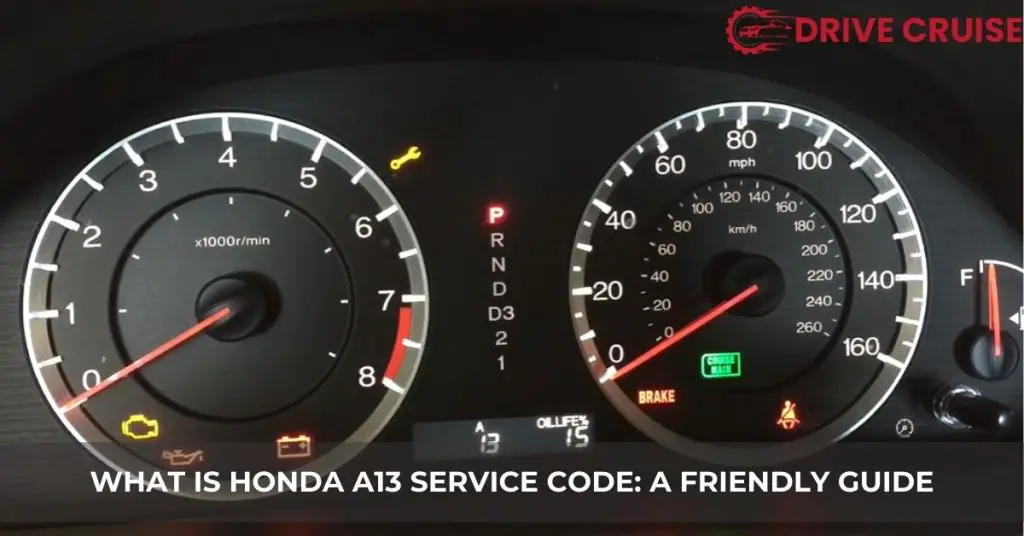When our dashboard lights up with a service code, it’s like our car is trying to tell us something important. And if you’re a Honda owner, seeing the A13 service code can be a bit puzzling. What’s it trying to communicate? Well, we’re here to demystify that for you.
The A13 code is more than just a random combination of letters and numbers; it’s a direct message about your vehicle’s health and what it needs to keep running smoothly. Understanding this code is crucial for maintaining the longevity and performance of your car. So, let’s dive into what the A13 service code means and why it’s important not to ignore it. After all, we all want our rides to be in top-notch condition, don’t we?
Understanding the Honda A13 Service Code
Recognizing the importance of the A13 service code can significantly influence the care and maintenance of a Honda vehicle. This code appears on the dashboard, signaling specific needs for the vehicle to continue running smoothly. Let’s break down the meaning of each component in the A13 code to grasp its significance fully.
The A13 code is a composite of three important maintenance tasks:
- A represents the need to replace the engine oil. Regular oil changes are fundamental in keeping the engine in good condition, ensuring it runs efficiently and extends its lifespan.
- 1 indicates that the vehicle’s tires need rotating. Tire rotation helps in achieving uniform wear for all tires, enhancing their longevity and maintaining the car’s balance and handling.
- 3 signifies that it’s time to replace the transmission fluid. This fluid is crucial for the transmission system’s operation, as it lubricates the moving parts and helps in dissipating heat. Over time, the fluid degrades and needs replacement to prevent wear and ensure smooth gear shifting.
Addressing the A13 service code involves more than just performing routine maintenance; it’s about understanding the vehicle’s needs to ensure its longevity and reliability. By promptly responding to this code, we help prevent larger, more expensive issues from arising, keeping the car running at its best. It’s always a good recommendation to consult with a professional mechanic or a certified Honda service center to ensure that the vehicle receives the appropriate care corresponding to the A13 service code.
By dissecting the Honda A13 service code and acknowledging its significance, we take a proactive step in vehicle maintenance. The tasks highlighted within this code are integral to the vehicle’s performance and safety, illustrating how simple maintenance can go a long way in ensuring the Honda stays in peak condition.
Importance of the A13 Service
Following the explanation of what constitutes the A13 service code for Honda vehicles, we dive into the importance of this specific maintenance schedule. Recognizing and adhering to the A13 service code is integral for several reasons, all pointing towards maximizing vehicle efficiency and reliability.
Firstly, routine oil changes, as indicated by the ‘A’ in A13, are fundamental in ensuring the engine runs smoothly. Oil acts as a lubricant, reducing friction between moving parts within the engine. Over time, oil breaks down and becomes less effective, making timely replacements critical to prevent engine damage.
Secondly, the ‘1’ represents tire rotation, a process crucial for achieving even tire wear. Even tire wear extends the lifespan of tires, maintains balanced handling, and improves fuel efficiency. Rotating tires as recommended helps in evenly distributing wear and tear, ensuring a safer driving experience.
Lastly, addressing the ‘3’ component, which stands for transmission fluid replacement, is vital for the health of the vehicle’s transmission system. Transmission fluid serves as both lubricant and coolant for the transmission parts. Fresh fluid affords better protection for the transmission, helps in maintaining smooth gear shifts, and can prevent costly transmission repairs down the line.
The A13 service code encompasses essential maintenance tasks, each contributing to the vehicle’s performance and safety. Ignoring these recommended services can lead to increased wear and tear, decreased fuel efficiency, and higher chances of major mechanical failures. Acting promptly on the A13 service alert not only ensures the longevity of the Honda but also maintains its resale value and reliability over time. Hence, we strongly advocate for taking these service codes seriously, recognizing their role as a guideline for keeping your vehicle in optimal condition.
What to Expect During an A13 Service
Understanding what’s involved in a Honda A13 service ensures you’re prepared when it’s time to bring in your vehicle. The core components of this service include an oil change, tire rotation, and transmission fluid replacement. Here’s a closer breakdown of each step and why they’re critical for your Honda’s health.
Oil Change
First, the oil change is paramount in keeping your Honda’s engine running smoothly. During an A13 service, technicians replace the old engine oil with fresh oil and swap out the oil filter. This process lubricates the engine parts, reduces friction, and helps in dissipating heat. Clean oil prevents the buildup of sludge and contaminants, extending the engine’s life.
Tire Rotation
Next, tire rotation involves moving the tires to different positions on the vehicle, such as from front to back or cross-diagonally. This practice ensures even tire wear, which is crucial for maintaining balanced handling and traction. Regular rotation can significantly extend the life of your tires, optimizing your Honda’s performance and safety.
Transmission Fluid Replacement
Finally, replacing the transmission fluid is a key task in the A13 service. This fluid serves many functions, including lubricating the transmission’s moving parts, cooling the transmission, and transmitting power from the engine to the transmission. Over time, the fluid degrades and needs replacement to keep the transmission operating efficiently and avoid costly repairs down the line.
During your A13 service appointment, certified technicians will carry out these essential maintenance tasks, ensuring your Honda remains reliable, efficient, and ready to serve you for many more miles. Remember, addressing the A13 service promptly when it appears will help prevent larger issues and maintain your vehicle’s performance and resale value.
Preparing for Your Service Appointment
After understanding the importance of the A13 service code for our Honda vehicles, ensuring a hassle-free service appointment becomes our next focus. The A13 service, comprising oil replacement, tire rotation, and transmission fluid change, is vital for our car’s performance and longevity. To prepare, there are a few steps we can take to ensure the service goes smoothly.
First and foremost, scheduling the appointment at a time that fits our schedule is crucial. Most dealerships offer online scheduling, making this process convenient and straightforward. When setting the appointment, mentioning the A13 service code ensures the service team is prepared with the necessary parts and fluids, reducing wait times.
Gathering our vehicle’s documents, including the service history and any previous repair records, is another essential step. These documents help the technicians understand our vehicle’s maintenance history, allowing for a more tailored service experience.
Checking our Honda for any specific issues and noting them down before the appointment can also be very helpful. If there’s a peculiar noise under the hood or a tire that seems to wear out faster than the others, letting the technicians know allows them to address these concerns during the A13 service.
Lastly, preparing for alternate transportation, if needed, ensures we’re not stranded. Some services may take longer than expected, and having a backup plan, like a ride from a friend or using the dealership’s shuttle service, keeps our day running smoothly.
By taking these simple steps, we can make our A13 service appointment efficient and stress-free, keeping our Honda in top shape and preserving its value and performance.
Cost Considerations
Discussing the cost considerations for the Honda A13 service code, it’s essential for us to understand that the price can vary significantly depending on several factors. First, the location of the service center plays a crucial role. Service centers in metropolitan areas often charge more due to higher operational costs compared to those in smaller towns. Second, whether one chooses a dealership or an independent mechanic affects the cost. Dealerships might be more expensive, but they offer specialized technicians and genuine parts. On the other hand, independent mechanics may provide more competitive rates.
Another important factor is the condition of the vehicle. If the car requires additional repairs beyond the standard A13 service tasks, the overall cost will increase. For example, replacing worn-out parts or addressing unforeseen issues discovered during the service can add to the total expense. Also, the type of vehicle can influence the cost. Certain models may require specific fluids or parts that are pricier than those needed for other models.
We’ve found that the average cost of an A13 service ranges roughly between $250 and $350. However, it’s always best to get a quote directly from the service provider before proceeding. They’ll provide an estimation based on the specific needs of your vehicle and any additional services you might request.
Lastly, we always recommend asking about service specials or discounts. Many dealerships and service centers offer promotions that could significantly reduce the cost. By considering these factors and tips, you can ensure that you’re prepared financially for the A13 service, maintaining your Honda’s performance and safety without any surprises to your budget.
Conclusion
We’ve walked through the nuts and bolts of understanding the A13 service code for our Honda vehicles. It’s clear that keeping up with these maintenance tasks not only ensures our car’s efficiency and safety but also protects its value over time. Whether we’re scheduling our next service appointment or budgeting for the cost, it’s essential we stay informed and proactive. By doing so we’re not just taking care of our car; we’re ensuring it takes care of us on every journey. So let’s make sure to follow through with the A13 service. After all it’s about maintaining the health of our vehicle and ensuring peace of mind on the road.







